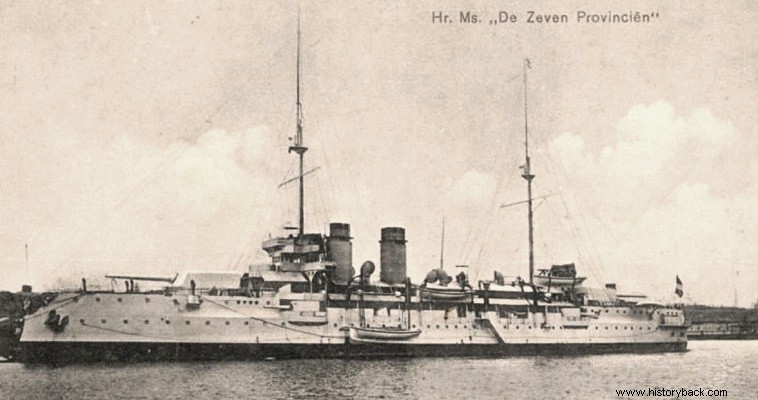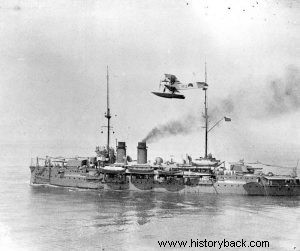
One of the most paradoxical incidents in world naval history concerns the mutiny on the Dutch battleship "De Zeven Provinciën" ("The Seven Provinces" =which made up the Netherlands). The vessel, a small coastal defense battleship in the terminology of the time, joined the fleet in 1910. She was 101.5m long, displaced 6,530 tons, had a top speed of 16 knots and carried two 283mm guns, four 150mm , 10 of 75 mm. four of 37 mm. and a 75mm howitzer. Its crew numbered 452 men.
The vessel joined the Dutch colonial fleet and was stationed at Surabaya, Indonesia in 1911. The vessel did not see active action as the Netherlands remained neutral in World War I and no rebellion occurred in the colonies.
The Mutiny
On February 5, 1933, however, the 50 Dutch and 190 Indonesians who were on board at that time rebelled and seized it. The mutiny was started by 10 Indonesian sailors, according to most sources. The mutineers drove the ship south, along the coast of Sumatra, without making a request to the authorities. After several days the then Dutch Minister of Defense Laurentius Dekker ordered an air attack on the ship. On February 10, five Dornier Do J Wal (Whale) jets and three Fokker T light bombers took off and searched for the battleship.
When they discovered it they attacked it with the small 50 kg bombs they had. A bomb from the D-11 aircraft hit the ship. 23 of the rebels were killed by the explosion. The others, completely terrified by the unexpected blow, announced that they were surrendering. Only after the surrender of the rebels was it possible to search for the causes of the mutiny, which, however, have never, until today, been clarified, with the mutiny remaining an unsolved historical mystery. Much was written then and is still being written today.
According to some the mutiny was due to communist sailors who were on board. But other scholars insist that the mutiny was a spontaneous, unpremeditated move, caused by the wage cuts that had been decided at the time and the harsh living conditions on the old ship, combined with the inhomogeneity of the crew and the generally low morale prevailing at that time in the Dutch navy. The mutiny on the Dutch battleship was strongly reminiscent of a mutiny that occurred some 18 months earlier on a British vessel and was unfailingly suppressed. Others, finally, attribute the mutiny to the tense situation prevailing in the Dutch colonies at the time.
Of the rebels, 40 were sentenced to many years in prison. The ship's master P.M Eikenboom and some officers were also convicted of dereliction of duty, as they were at a party ashore when the mutiny broke out. The captain was sentenced to 4 months in prison and was dismissed from the navy.
The aftermath
The impact of the mutiny on Dutch society was enormous. For the Dutch, to this day, the mutiny is considered the most important event in their country's history in the 1930s. when there was a noticeable shift of the electorate to the right of the political spectrum. The new government of retired officer Hendrikus Kolijn that emerged acted decisively to eradicate any socialist-leftist influence in the armed forces, but also in the public administration.
Hitler's Dutch Nazi followers also benefited from the incident, gaining votes, members and influence. Only the Dutch Communist Party he saw the mutiny as the "beginning of the anti-colonial revolution". But the head of the party, Henk Schneevliet, who welcomed the rebellion, was imprisoned for five months.
As for the ship, after it was repaired, it was again assigned to the colonial navy under the name "Soerabaja". In World War II the old battleship fought against the Japanese and was sunk, in the shallows, by Japanese bombers in the port of Surabaya, whose name it bore, on February 18, 1942. The Japanese raised it when they occupied Indonesia and used it as a floating gun to cover the port. It was Allied bombs that sank it for good, in 1943.

